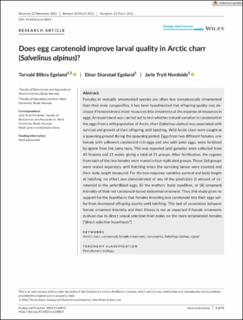| dc.contributor.author | Egeland, Torvald B. | |
| dc.contributor.author | Egeland, Einar Skarstad | |
| dc.contributor.author | Nordeide, Jarle Tryti | |
| dc.date.accessioned | 2022-07-29T14:21:23Z | |
| dc.date.available | 2022-07-29T14:21:23Z | |
| dc.date.created | 2022-05-13T11:25:36Z | |
| dc.date.issued | 2022 | |
| dc.identifier.citation | Egeland, T. B., Egeland, E. S., & Nordeide, J. T. (2022). Does egg carotenoid improve larval quality in Arctic charr (Salvelinus alpinus)? Ecology and Evolution, 12(4), e8812. doi: | en_US |
| dc.identifier.issn | 2045-7758 | |
| dc.identifier.uri | https://hdl.handle.net/11250/3009207 | |
| dc.description.abstract | Females in mutually ornamented species are often less conspicuously ornamented than their male conspecifics. It has been hypothesized that offspring quality may de-crease if females invest more resources into ornaments at the expense of resources in eggs. An experiment was carried out to test whether natural variation in carotenoid in the eggs from a wild population of Arctic charr (Salvelinus alpinus) was associated with survival and growth of their offspring until hatching. Wild Arctic charr were caught at a spawning ground during the spawning period. Eggs from two different females, one female with yellowish carotenoid- rich eggs and one with paler eggs, were fertilized by sperm from the same male. This was repeated until gametes were collected from 42 females and 21 males, giving a total of 21 groups. After fertilization, the zygotes from each of the two females were reared in four replicated groups. These 168 groups were reared separately until hatching when the surviving larvae were counted and their body length measured. For the two response variables survival and body length at hatching, no effect was demonstrated of any of the predictors (i) amount of ca-rotenoid in the unfertilized eggs, (ii) the mothers' body condition, or (iii) ornament intensity of their red carotenoid- based abdominal ornament. Thus, this study gives no support for the hypothesis that females investing less carotenoid into their eggs suf-fer from decreased offspring quality until hatching. This lack of association between female ornament intensity and their fitness is not as expected if female ornaments evolved due to direct sexual selection from males on the more ornamented females (“direct selection hypothesis”). | en_US |
| dc.description.abstract | Does egg carotenoid improve larval quality in Arctic charr (Salvelinus alpinus)? | en_US |
| dc.language.iso | eng | en_US |
| dc.publisher | Wiley | en_US |
| dc.relation.uri | https://onlinelibrary.wiley.com/doi/epdf/10.1002/ece3.8812 | |
| dc.rights | Navngivelse 4.0 Internasjonal | * |
| dc.rights.uri | http://creativecommons.org/licenses/by/4.0/deed.no | * |
| dc.title | Does egg carotenoid improve larval quality in Arctic charr (Salvelinus alpinus)? | en_US |
| dc.title.alternative | Does egg carotenoid improve larval quality in Arctic charr (Salvelinus alpinus)? | en_US |
| dc.type | Peer reviewed | en_US |
| dc.type | Journal article | en_US |
| dc.description.version | publishedVersion | en_US |
| dc.rights.holder | © 2022 The Authors | en_US |
| dc.subject.nsi | VDP::Matematikk og Naturvitenskap: 400::Zoologiske og botaniske fag: 480::Zoofysiologi og komparativ fysiologi: 483 | en_US |
| dc.subject.nsi | VDP::Matematikk og Naturvitenskap: 400::Zoologiske og botaniske fag: 480::Marinbiologi: 497 | en_US |
| dc.subject.nsi | VDP::Matematikk og Naturvitenskap: 400::Zoologiske og botaniske fag: 480::Økologi: 488 | en_US |
| dc.source.pagenumber | 11 | en_US |
| dc.source.volume | 12 | en_US |
| dc.source.journal | Ecology and Evolution | en_US |
| dc.source.issue | 4 | en_US |
| dc.identifier.doi | 10.1002/ece3.8812 | |
| dc.identifier.cristin | 2024305 | |
| dc.source.articlenumber | e8812 | en_US |

